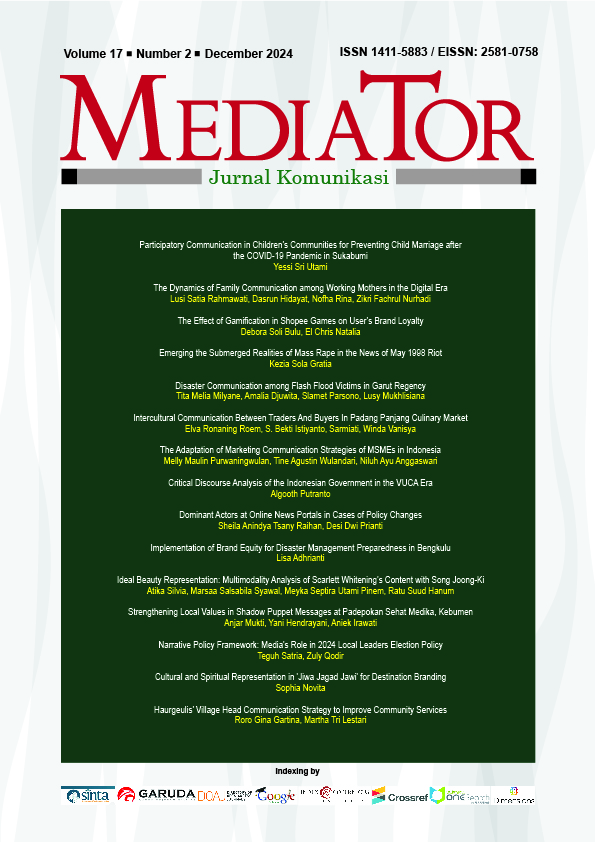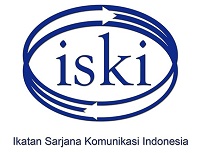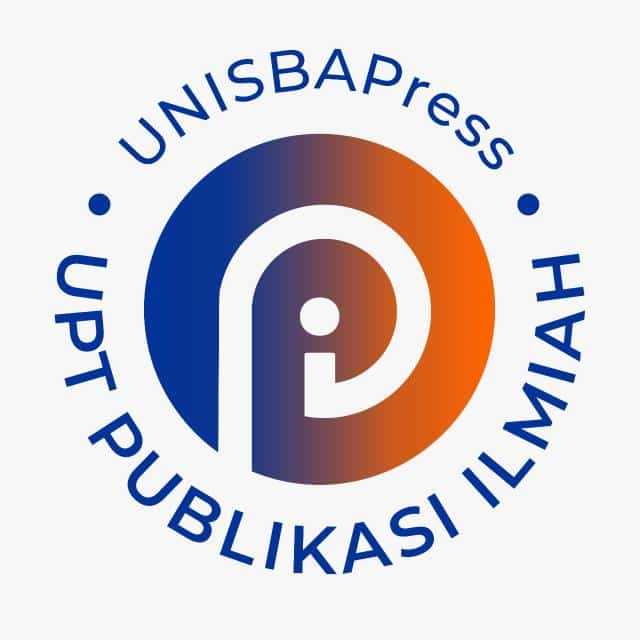Dominant Actors at Online News Portals in Cases of Policy Changes
DOI:
https://doi.org/10.29313/mediator.v17i2.4444Keywords:
Discourse Network Analysis (DNA), Policy Change, Online News Portal, Discourse Coalition TheoryAbstract
The media has contributed significantly to the polemic regarding the age limit of prospective presidential candidates in Indonesia. To answer how the media contributes to this polemic, this study applies discourse network (DNA) analysis. By looking at three leading online media outlets in Indonesia, Viva.co.id, Tempo.co Dan Mediaindonesia.com in October 2023-January 2024, this study argues that the discrepancy around the age limit of presidential candidates not only affects the way the public views the issue but also exposes the public to the issue of transparency of the highest constitutional institution in Indonesia (MK). Moreover, by applying the Discourse Coalition Framework (DCF), this study found that Mediaindonesia.com and Tempo.co have the same views regarding the issue of age restrictions, which are harmful to the Constitutional Court’s policies. Meanwhile, Viva is relatively supportive and agrees with the policy. Media organizations use influential individuals to build discourse as part of the narrative. They use these people as their source to support certain discourses. These people range from academics, activists, and political parties to speaking experts to experts.
References
Atkinson, J. D., & Cooley, L. (2019). Narrative capacity, resistance performance, and the “shape” of new social movement networks. Communication Studies, 61(3), 321–338. https://doi.org/10.1080/10510971003752668
Brandes, U., & Wagner, D. (2004). Analysis and Visualization of Social Networks BT - Graph Drawing Software (M. Jünger & P. Mutzel, Eds.). Berlin, Heidelberg: Springer Berlin Heidelberg. https://doi.org/10.1007/978-3-642-18638-7_15
Breindl, Y. (2013). Discourse networks on state-mandated access blocking in Germany and France. Info, 15(6), 42–62. https://doi.org/10.1108/info-03-2013-0011
Buckton, C. H., Fergie, G., Leifeld, P., & Hilton, S. (2019). A discourse network analysis of UK newspaper coverage of the “sugar tax” debate before and after the announcement of the Soft Drinks Industry Levy. BMC Public Health, 19(1), 1–14. https://doi.org/10.1186/s12889-019-6799-9
Eriyanto, & Ali, D. J. (2020). Discourse network of a public issue debate: A study on covid-19 cases in indonesia. Jurnal Komunikasi: Malaysian Journal of Communication, 36(3), 209–227. https://doi.org/10.17576/JKMJC-2020-3603-13
Fergie, G., Leifeld, P., Hawkins, B., & Hilton, S. (2019). Mapping discourse coalitions in the minimum unit pricing for alcohol debate: a discourse network analysis of UK newspaper coverage. Addiction, 114(4), 741–753. https://doi.org/10.1111/add.14514
Fisher, D. R., Leifeld, P., & Iwaki, Y. (2013). Mapping the ideological networks of American climate politics. Climatic Change, 116(3–4), 523–545. https://doi.org/10.1007/s10584-012-0512-7
Ghinoi, S., & Steiner, B. (2020). The political debate on climate change in Italy: A discourse network analysis. Politics and Governance, 8(2), 215–228. https://doi.org/10.17645/pag.v8i2.2577
Ibrahim, I. S., Amirudin, A., & Kustiman, E. (2023). Representations of Stunting in Indonesian National Newspaper: Positioning a Culture-Oriented Approach. Mediator: Jurnal Komunikasi, 16(2), 290–302. https://doi.org/10.29313/mediator.v16i2.2922
Kukkonen, A., & Ylä-Anttila, T. (2020). The science-policy interface as a discourse network: Finland’s climate change policy 2002-2015. Politics and Governance, 8(2), 200–214. https://doi.org/10.17645/pag.v8i2.2603
Leifeld, P. (2016a). Discourse Network Analysis: Policy Debates as Dynamic Networks. 1–48.
Leifeld, P. (2016b, September 20). Discourse Network Analysis: Policy Debates as Dynamic Networks (J. N. Victor, A. H. Montgomery, & M. Lubell, Eds.). The Oxford Handbook of Political Networks, p. 0. Oxford University Press. https://doi.org/10.1093/oxfordhb/9780190228217.013.25
Leifeld, P. (2017). Discourse Network Analysis: Policy Debates as Dynamic Networks. The Oxford Handbook of Political Networks, (July 2016), 301–326.
Leifeld, P., & Haunss, S. (2010). A Comparison between Political Claims Analysis and Discourse Network Analysis: The Case of Software Patents in the European Union. SSRN Electronic Journal. https://doi.org/10.2139/ssrn.1617194
Leifeld, P., & Haunss, S. (2012). Political Discourse Networks and the Conflict over Software Patents in Europe. European Journal of Political Research, 51, 382–409. https://doi.org/10.1111/j.1475-6765.2011.02003.x
Martinez, M. (2021). Discourse Coalitions and the Messiness of Policy Solutions: College Governance in Nevada. In P. Zittoun, F. Fischer, & N. Zahariadis (Eds.), The Political Formulation of Policy Solutions: Arguments, Arenas, and Coalitions (pp. 151–172). Bristol University Press. https://doi.org/DOI: 10.46692/9781529210354.008
Muller, A. (2015). Using Discourse Network Analysis to Measure Discourse Coalitions: Towards a Formal Analysis of Political Discourse. 11(2), 377–404. https://doi.org/doi:10.1515/wps-2015-0009
Nagel, M., & Satoh, K. (2018). They were protesting iconic megaprojects. A discourse network analysis of the evolution of the conflict over Stuttgart 21. Urban Studies, 56(8), 1681–1700. https://doi.org/10.1177/0042098018775903
Nohrstedt, D., & Heinmiller, T. (2024). Advocacy coalitions as political organizations. Policy and Society, 43(3), 304–316. https://doi.org/10.1093/polsoc/puae005
Putra, R. P., Rachmawati, I., & Cholifah, Y. W. (2021). Digital Information Media of the Salman ITB Halal Center in improving Marketing Performance of Halal Lecture Program. Mediator: Jurnal Komunikasi, 14(1), 42–53. https://doi.org/10.29313/mediator.v14i1.6992
Sri Pujianti, T. A. (2024). PSI Minta Batas Usia Minimal Capres-Cawapres 35 Tahun - Mahkamah Konstitusi Republik Indonesia. Retrieved January 20, 2024, from Mahkamah Konstitusi Republik Indonesia website: https://www.mkri.id/index.php?page=web.Berita&id=19076&menu=2https://www.mkri.id/public/content/persidangan/putusan/putusan_mkri_9329_1697427307.pdf
Steinfeld, N. (2016). The F-campaign: a discourse network analysis of party leaders’ campaign statements on Facebook. Israel Affairs, 22(3–4), 743–759. https://doi.org/10.1080/13537121.2016.1174385
Wagner, P., & Payne, D. (2017). Trends, frames and discourse networks: analysing the coverage of climate change in Irish newspapers. Irish Journal of Sociology, 25(1), 5–28. https://doi.org/10.7227/IJS.0011
Wallaschek, S., Starke, C., & Brüning, C. (2020). Solidarity in the public sphere: A discourse network analysis of German newspapers (2008-2017). Politics and Governance, 8(2), 257–271. https://doi.org/10.17645/pag.v8i2.2609
Yun, S. J., Ku, D., Park, N. B., & Han, J. (2014). Framing climate change as an economic opportunity in South Korean newspapers. Development and Society, 43(2), 219–238. https://doi.org/10.21588/dns.2014.43.2.005
Downloads
Published
Issue
Section
License
Copyright (c) 2024 Sheila Anindya Tsany Raihan, Desi Dwi Prianti

This work is licensed under a Creative Commons Attribution-ShareAlike 4.0 International License.























